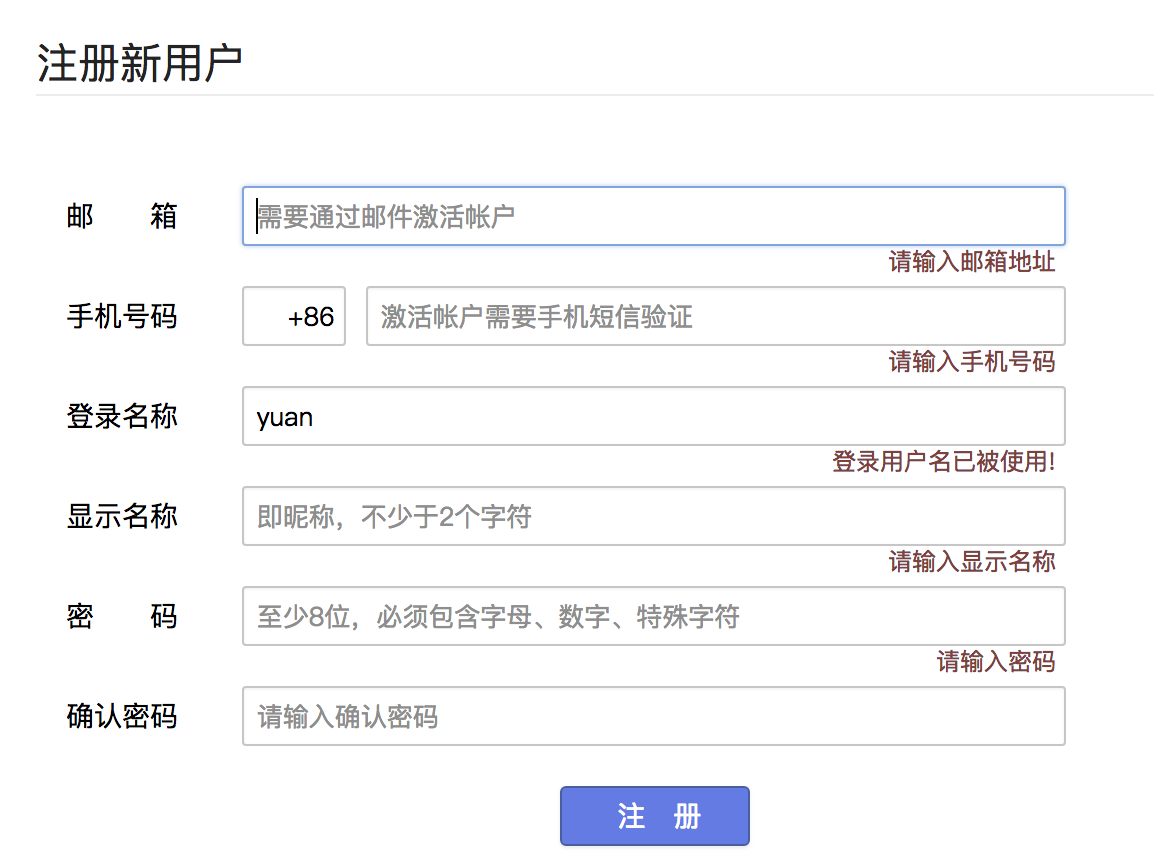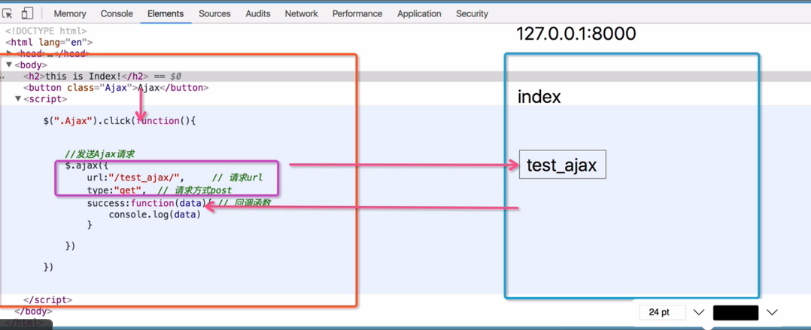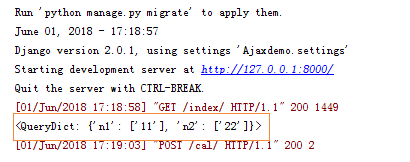Ajax
AJAX(Asynchronous Javascript And XML)翻译成中文就是“异步Javascript和XML”。即使用Javascript语言与服务器进行异步交互,传输的数据为XML(当然,传输的数据不只是XML,现在更多使用json数据)。
- 同步交互:客户端发出一个请求后,需要等待服务器响应结束后,才能发出第二个请求;
- 异步交互:客户端发出一个请求后,无需等待服务器响应结束,就可以发出第二个请求。
AJAX除了异步的特点外,还有一个就是:浏览器页面局部刷新;(这一特点给用户的感受是在不知不觉中完成请求和响应过程)
场景:

优点:
- AJAX使用Javascript技术向服务器发送异步请求
- AJAX无须刷新整个页面
jquery cdn百度 src="http://ajax.aspnetcdn.com/ajax/jquery/jquery-2.1.4.min.js"></script>
index.html
<!DOCTYPE html> <html lang="en"> <head> <meta charset="UTF-8"> <title>Title</title> <script src="http://ajax.aspnetcdn.com/ajax/jquery/jquery-2.1.4.min.js"></script> </head> <body> <h2>this is Index!</h2> <button class="Ajax">Ajax</button> <p class="content"></p> <script> $(".Ajax").click(function(){ //alert(123) //发送ajax请求 $.ajax({ url:"/test_ajax/" , //请求url,不加地址它会找默认当前脚本的ip地址和端口 type:"get", //请求方式 success: function (data) { //回调函数,某个事件执行完之后再去执行的函数 console.log(data); $(".content").html(data); } }) }) </script> </body> </html>

执行过程:
一点击Ajax按钮,触发click这个函数,然后发就要发生ajax,给test_ajax发路径请求,当url匹配成功后,它把请求的结果交给了data,刚刚那个hello kris就交给了data;然后再执行那个回调函数能够打印,用js处理data.

Ajax数据传递
urls
from django.contrib import admin from django.urls import path from app01 import views urlpatterns = [ path('admin/', admin.site.urls), path('index/', views.index), path('test_ajax/', views.test_ajax), path('cal/', views.cal), ]
views.py
from django.shortcuts import render, HttpResponse # Create your views here. def index(request): return render(request, "index.html") def test_ajax(request): print(request.GET) return HttpResponse("Hello kris") def cal(request): print(request.POST) n1=int(request.POST.get("n1")) n2=int(request.POST.get("n2")) ret = n1+n2 return HttpResponse(ret)
index.html
1 <!DOCTYPE html> 2 <html lang="en"> 3 <head> 4 <meta charset="UTF-8"> 5 <title>Title</title> 6 <script src="http://ajax.aspnetcdn.com/ajax/jquery/jquery-2.1.4.min.js"></script> 7 </head> 8 <body> 9 <h2>this is Index!</h2> 10 <button class="Ajax">Ajax</button> 11 <p class="content"></p> 12 13 <hr> 14 <input type="text" id="num1">+<input type="text" id="num2">=<input type="text" id="ret"><button class="cal">计算</button> 15 <script> 16 $(".Ajax").click(function(){ 17 //alert(123) 18 //发送ajax请求 19 $.ajax({ 20 url:"/test_ajax/" , //请求url,不加地址它会找默认当前脚本的ip地址和端口 21 type:"get", //请求方式 22 data:{a:1,b:2}, 23 success: function (data) { //回调函数,某个事件执行完之后再去执行的函数 24 console.log(data); 25 26 $(".content").html(data); 27 } 28 }) 29 }) 30 //Ajax计算求值 31 $(".cal").click(function () { 32 $.ajax({ 33 url:"/cal/", 34 type:"post", 35 data:{ 36 "n1":$("#num1").val(), 37 "n2":$("#num2").val(), 38 }, 39 success: function (data) { 40 console.log(data); 41 $("#ret").val(data); 42 } 43 }) 44 }) 45 </script> 46 47 </body> 48 49 50 </html>


基于Ajax的登录验证
用户在表单输入用户名与密码,通过Ajax提交给服务器,服务器验证后返回响应信息,客户端通过响应信息确定是否登录成功,成功,则跳转到首页,否则,在页面上显示相应的错误信息。
models
from django.db import models # Create your models here. class User(models.Model): name = models.CharField(max_length=32) pwd = models.CharField(max_length=32)
views
from app01.models import User def login(request): print(request.POST) user = request.POST.get("user") pwd = request.POST.get("pwd") user = User.objects.filter(name=user, pwd=pwd).first() res = {"user":None, "msg":None} if user: res["user"] = user.name else: res["msg"] = "username or password wrong!" import json #想把res这个字典交给data return HttpResponse(json.dumps(res))
index
<!DOCTYPE html> <html lang="en"> <head> <meta charset="UTF-8"> <title>Title</title> <script src="http://ajax.aspnetcdn.com/ajax/jquery/jquery-2.1.4.min.js"></script> </head> <body> <form> 用户名<input type="text" id="user"> 密码<input type="password" id="pwd"> <input type="button" value="submit" class="login_btn"><span class="error"></span> </form> <script>//登录验证 $(".login_btn").click(function () { $.ajax({ url:"/login/", type:"post", data:{ "user":$("#user").val(), "pwd":$("#pwd").val(), }, success:function(data){ console.log(data); //json字符串 console.log(typeof data); var data = JSON.parse(data) //js再给它反序列化 object{} console.log(data); //反序列化类似字典的object console.log(typeof data); if (data.user){ location.href="http://www.baidu.com" } else { $(".error").html(data.msg).css({"color":"red","margin-left":"10px"}) } } }) }) </script> </body> </html>
基于form表单上传文件
views
def file_put(request): if request.method == "POST": print(request.POST) #用户上传的数据 print(request.FILES) #拿到这个文件 file_obj = request.FILES.get("avatar") #把文件下载来 with open(file_obj.name, "wb")as f: #上传的文件名file_obj.name for line in file_obj: f.write(line) return HttpResponse("ok") return render(request, "file_put.html")
file_put
<!DOCTYPE html> <html lang="en"> <head> <meta charset="UTF-8"> <title>Title</title> </head> <body> <h3>基于form表单的文件上传</h3> <form action="" method="post" enctype="multipart/form-data"> 用户名<input type="text" name="user"> 头像<input type="file" name="avatar"> <input type="submit"> </form> </body> </html>

请求头ContentType:urlencoed
file_put
<!DOCTYPE html> <html lang="en"> <head> <meta charset="UTF-8"> <title>Title</title> <script src="http://ajax.aspnetcdn.com/ajax/jquery/jquery-2.1.4.min.js"></script> </head> <body> <h3>简单的form</h3> <form action="" method="post" enctype="application/x-www-form-urlencoded"> {#普通的键值只能用这种#} 用户名<input type="text" name="user"> 密码<input type="password" name="pwd"> <input type="submit"> </form> <h3>基于form表单的文件上传</h3> <form action="" method="post" enctype="multipart/form-data"> 用户名<input type="text" name="user"> 头像<input type="file" name="avatar"> <input type="submit"> </form> <h3>基于Ajax文件上传</h3> <form action="" method="post"> 用户名<input type="text" name="user"> <input type="button" class="btn" value="Ajax"> </form> <script> $.ajax({ url:"", type:"post", data:{ a:1, b:2 }, //无论是ajax还是form它们都有一个默认的请求头ContentType:urlencoed ,把我们写好的数据按照某种类型编码好之后放到请求体中,然后把整个报文部分发给服务器 success: function (data) { console.log(data) } }) </script> </body> </html>
Ajax传递json数据
file_put
<h3>基于Ajax文件上传</h3> <form action="" method="post"> 用户名<input type="text" name="user"> <input type="button" class="btn" value="Ajax"> </form> <script> $.ajax({ url:"", type:"post", contentType:"application/json", data:JSON.stringify({ a:1, b:2 }), //无论是ajax还是form它们都有一个默认的请求头ContentType:urlencoed ,把我们写好的数据按照某种类型编码好之后放到请求体中,然后把整个报文部分发给服务器 success: function (data) { console.log(data) } }) </script>
views
def file_put(request): if request.method == "POST": print("body",request.body) #请求报文中的请求体 print("post",request.POST) #用户上传的数据; 只有在ContentType:urlencoed时,request.POST才有数据 return HttpResponse("ok") return render(request, "file_put.html") ''' 请求首行 请求体 ''' ''' ContentType:urlencoed 请求头 这样的编码格式 ;multipart/form-data文件上传只能用这种 请求体(a=1&b=2&c=3) '''
基于Ajax文件上传
file_put
//Ajax上传文件 $(".btn").click(function () { var formdata=new FormData(); formdata.append("user",$("#user").val()); {#不断的append键值#} formdata.append("avatar",$("#avatar")[0].files[0]); $.ajax({ url:"", type:"post", contentType:false, processData:false, data:formdata, //把整个formdata对象放到data里边 success: function (data) { console.log(data) } }) })
views.py
def file_put(request): if request.method == "POST": print("body",request.body) #请求报文中的请求体 print("post",request.POST) #用户上传的数据; 只有在ContentType:urlencoed时,request.POST才有数据 print(request.FILES) #拿到这个文件 file_obj = request.FILES.get("avatar") #把文件下载来 with open(file_obj.name, "wb")as f: #上传的文件名file_obj.name for line in file_obj: f.write(line) return HttpResponse("ok") return render(request, "file_put.html")

